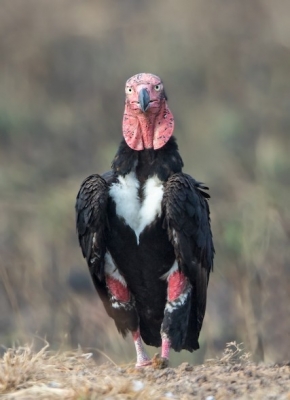
The red-headed vulture, or Sarcogyps calvus, also known as the Asian king vulture, Indian black vulture and the Pondicherry vulture, is mainly found on the Indian sub-continent.
As the name suggests the red-headed vulture has a red head. It also has a red neck, wattle, thighs and legs. It has a black beak and its wings and back are covered in black and white feathers. Once abundant in large parts of India and south central and south eastern Asia, it is found today mainly in northern India in open country and in cultivated areas. It is also found in deciduous forests and foothills and river valleys up to an altitude of 3000 m from sea level.
This vulture is, unlike the rest, a solitary feeder. You must have heard of the term, ‘a wake of feeding vultures’. The collective noun ‘wake’ is applied to vultures because they usually congregate in groups to feed. However the red-headed vulture prefers its solitude and feeds alone or in pairs.
It builds large, flat nests on tall trees. Both males and females build the nest together using sticks and twigs and lining it with grass, fur or wool. The female will lay a single, white egg and incubation, which lasts for 2 months, is carried out by both parents.
Like most vultures, the red-headed vulture doesn’t make a lot of noise. It prefers to perch or soar in silence as it observes the world around it or forages for food. However, it will croak and hiss when in battle with another vulture for the first bite of a carcass.
The red-headed vulture population has declined drastically since the late 1990s. It is listed as ‘Critically endangered’ in the IUCN Red List.
Picture Credit : Google




